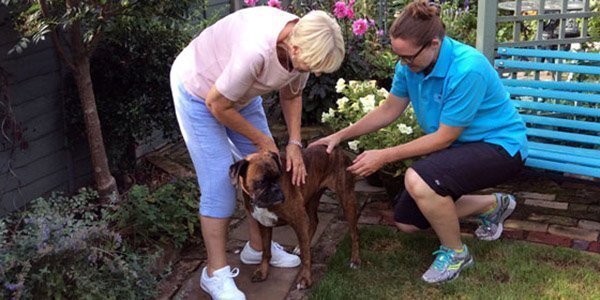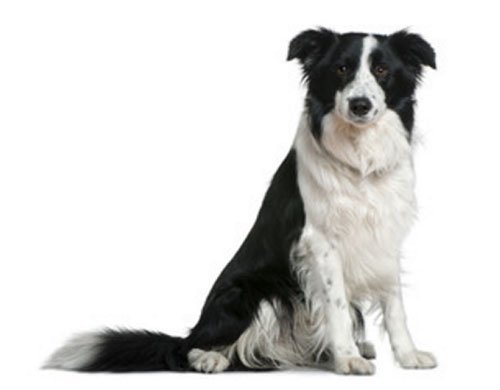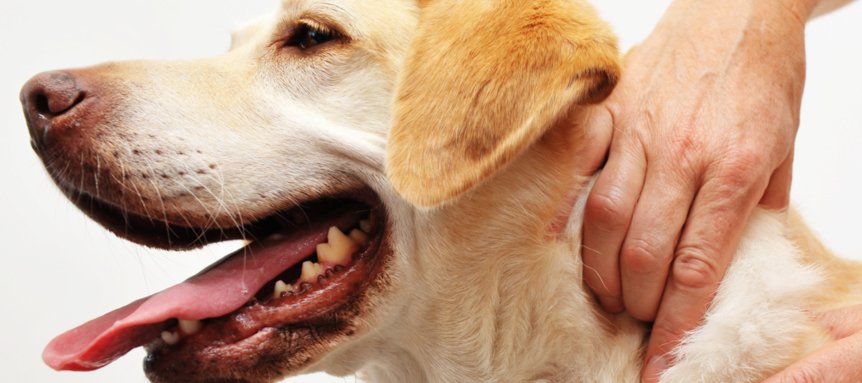Why Dog Massage Therapy?
Does your dog need help?
Muscle pain is often underestimated and sometimes difficult to diagnose and treat. We have specialised knowledge in this area and work in a targeted and specific way, through dog massage therapy, which often results in remarkable positive changes within the dog as a whole.
Muscular issues can manifest themselves in many different ways. The pain can cause stress that will have a negative effect on how the dog functions both physically and emotionally.
Physical pain indicators

Does your dog have a mobility issue? Perhaps they are reluctant to go up or down stairs, or are unable to get in and out of the car? Is the sofa now unreachable?
You may have noticed that your dog has started to look more stiff-legged recently, and perhaps they are stretching more (or less) than usual. Does Rover just not ‘look right’?
Maybe your sporting or working dog is exhibiting performance issues? Have they started knocking down jumps in the agility ring?
Emotional pain indicators

One of the ways your dog can tell you they are in pain is through their behaviour. Does your dog constantly lick its paws or chase its tail?
Have they become more nervous, anxious or seemingly depressed? Are they more aggressive, protective of their space, or increasingly averse to you touching them? Are they old before their time — has their sparkle fizzled?
Perhaps going for a splash in a muddy puddle or a long romp in a field is just no fun anymore?
How dog massage therapy can help
At Big Brown Dog Canine Massage Therapy we can help with the treatment of dogs with postural and loading issues, damaged or injured muscle and allied soft tissue. The treatment is primarily intended for the long-term case that could have been a result of compensatory issues from a condition (i.e. osteoarthritis or hip dysplasia), past trauma or repetitive strain.
Dog massage therapy has discernible effects on the body’s various organ systems. It helps to keep the organ tissues healthy and promotes healing so that the function and efficiency of the whole body is enhanced.
Because the main body systems do not work in isolation, the benefits of massage on one system will impact others as well.
Skeleton, joints and muscles
The skeletal and muscular systems work together to provide levers for movement and posture.
In order for the muscular system to function at its optimum potential, secure joints and muscle attachments are vital for muscular and skeletal stability.
Any weaknesses within the skeletal system can cause imbalance within the muscular system, and vice versa.
Massage can improve muscle tone and balance, thus facilitating less stress and better support to the skeletal system.
Other physiological benefits
Physiologically massage can invigorate, increase, improve, strengthen, regenerate and relax the body’s organ systems, which improves their overall function.
Massage stimulates an increased and more efficient circulation of blood to tissues and organs which can help to relieve muscular and joint pain. This also has a beneficial effect on muscle recovery and growth, as well as promoting the natural healing process.
Furthermore, massage can enhance the transport of waste materials from the cells, as well as promoting an increase in the flow of oxygen, hormones and nutrients to cells, tissues and organs.
Well-being and pain relief
Psychologically, massage creates a general feeling of well-being, which is linked with the physical release of endorphins (the body’s natural painkillers) via the nervous system, promoting a ‘natural high’ and can be effective in the reduction, and sometimes, the elimination of pain. As a result, it allows the mind to ‘switch off’ and unwind, and helps to reduce the mental stress associated with being in pain.
Another side benefit is that massage fulfils the body’s need to touch – the importance of which is not only reserved for humans. It can be said that for most dogs, the right touch by a human is a calming, bonding experience.
How we work with you and your dog
Our five-step approach is: Question — Observe — Feel — Treat — Advise.1. Question
We want to know as much about your dog as possible. This helps us to build the bigger picture regarding their physical and behavioural health, as well as their exercise levels and home environment.
We will ask a lot of questions, for example: Is your dog’s history known? What type of flooring do you have in the home? How often and how far is your dog walked? What games do you play with your dog? Have there been any recent noticeable changes in their behaviour?


2. Observe
How does your dog carry their head? How do they position their body, legs and tail? We observe your dog while they are standing and sitting and spend time to compare the various body parts in relation to each other and consider size, proportion and alignment. This way we can get a general impression of your dog’s state of health and fitness, and detect any areas of possible imbalance.
Does your dog move with purpose? Do they appear confident and comfortable? We will observe how your dog moves during a slow walk – from the front, the side and the rear. We are looking for abnormalities, including any restriction or signs of discomfort. Any lameness during the walking assessment may indicate a possible muscular problem.
3. Feel
We assess through palpation to ascertain and locate areas of:
- Overworking or underworking muscle tone
- Stretched, tight and stiff muscle tone
- Sensitivity and tenderness
- Fibrous change (this indicates the age of the muscular issue)
- Variations in body temperature (hot/cold areas)
- Scar tissue and the resultant effects
- Adhesions through fascia and superficial muscle groups
- Quality of skin and coat
- Level of joint flexibility

4. Treat
We will handle your dog with respect, sympathy and patience. We do not use massage tables and only treat on the floor or a low sofa. We will not restrain your dog in any way and we very rarely have to use muzzles. A full massage treatment usually takes 45 – 60 minutes. We will adapt the treatment to suit the needs of your dog and situation, as each dog is individual so no treatment is ever the same
5. Advise
Before we can treat your dog we will need the formal go-ahead from your vet. Big Brown Dog Canine Massage Therapy acknowledges and respects the Veterinary Surgeons Act 1966 and Exemption Order 1962 by never working upon an animal without gaining prior veterinary approval.
As part of our service, we will contact your vet on your behalf and will arrange for veterinary consent for massage therapy before your first appointment.
Please note that without consent we are unable to treat your dog.
Does it work?
Yes, it does! Massage has a profound overall effect on animals.
The direct physical effects of massage on the body’s tissues will increase blood circulation, enhance the delivery of important nutrients, hormones and fresh oxygen, as well as aid the removal of toxins.
Massage will loosen tight muscle fibres, knots, spasms and helps to realign scar tissue.
After a massage treatment, your dog should exhibit:
- Improved movement patterns, lameness and posture
- Reduction in pain and stiffness
- Increased joint flexibility and range of motion
- Improved condition of skin and coat
- Improved sports performance
- Quicker recovery from injury
- Quicker postoperative recovery
Massage can also offer temporary relief from chronic on-going orthopaedic conditions

(i.e. hip/elbow dysplasia, arthritis) by easing the tension in over-compensating muscles.
The benefits aren’t limited to physical improvements. Remove the stress of pain from your dog and they will benefit from an improved mood, be emotionally ‘lifted’ – they will enjoy life again!
Some owner observations after treatment:
- Dog jumped up on sofa/bed again
- Dog engaged and ran with its doggy friends
- Dog did not growl/hide from other dogs
- Dog accepted being groomed
- Dog has learned to be naughty again!